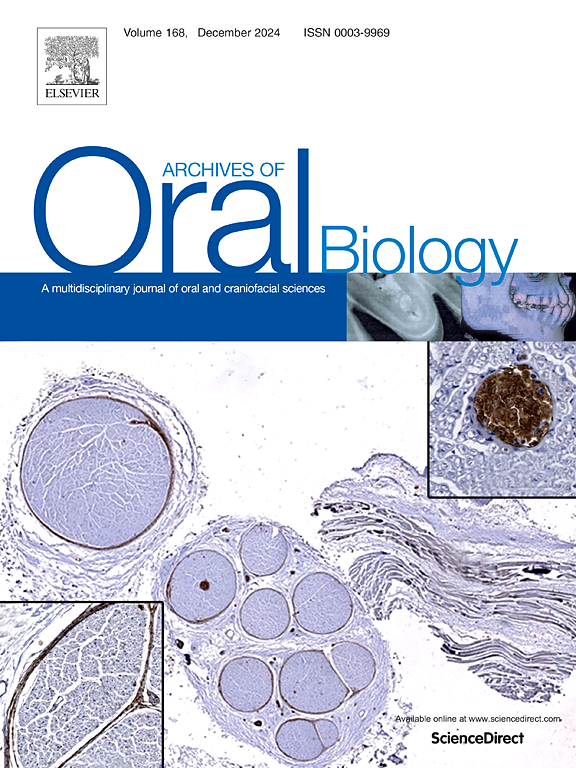Sensory innervation of rat molar root pulp and dentin, apex, foramen, cellular cementum, vasculature and periodontium
IF 2.2
4区 医学
Q2 DENTISTRY, ORAL SURGERY & MEDICINE
引用次数: 0
Abstract
Objective
Trigeminal innervations of dental roots have only been partly investigated. The aim of this study was to document sensory innervation of rat molar roots, especially their neural patterns in periapical tissues that may affect tooth pain.
Design
Trigeminal nerve ending patterns in young and old rat molars that had been labeled by tritiated axonal-transported protein were compared by immunocytochemistry for neural peripherin, calcitonin gene-related peptide, p75-neurotrophin receptor, synaptophysin, Substance P, and neurofilament-200.
Results
Nine sensory nerve patterns were found in the autoradiograms: (1) PERIAPICAL PULP had large axons ending among odontoblasts, other axons with free endings in pulp, plus innervation of dentin on the palatal-lingual and buccal sides of each root. (2) CELLULAR CEMENTUM MATRIX (CCx) had small nerve channels extending across from periodontium to apex, plus trigeminal endings in the CCx at its apical and periodontal edges. (3) THE FORAMEN REGION had many free axons plus much vascular innervation. (4) THE APEX had a variety of axons ending along its walls. (5) NEARBY PERIODONTIUM had neurovascular clusters including trigeminal axons and Ruffini mechanoreceptors near the foramen. Immunocytochemistry showed that CGRP, peripherin, synaptophysin, and p75-neurotrophin receptor each had individual neural patterns in periapical tissues, while Substance P and neurofilament protein were more limited. Differences between lateral and accessory canals were noted.
Conclusion
The nine periapical trigeminal innervation patterns identified so far differ from crown and root shaft. They likely have important effects on tooth pain in general and on periapical pains that can be difficult to anesthetize and treat.
大鼠磨牙根髓和牙本质、牙尖、牙孔、细胞骨质、脉管系统和牙周组织的感觉神经支配
目的对牙根的三叉神经支配进行了部分研究。本研究的目的是记录大鼠磨牙根的感觉神经支配,特别是它们在根尖周围组织的神经模式,可能影响牙齿疼痛。设计采用免疫细胞化学方法比较了经轴突转运蛋白标记的幼龄和老年大鼠磨牙三叉神经末梢的神经外周素、降钙素基因相关肽、p75-神经营养因子受体、突触素、P物质和神经丝-200的表达。结果x线自显影显示:(1)牙髓尖周有大的轴突末梢,其余轴突末梢游离于牙髓内,牙本质神经支配在腭、舌侧和颊侧。(2) CELLULAR CEMENTUM MATRIX (CCx)具有小的神经通道,从牙周膜延伸至牙周尖,在CCx的根尖和牙周边缘有三叉神经末梢。(3)孔区有大量的自由轴突和大量的血管神经支配。(4)顶端有各种各样的轴突,沿其壁端结束。(5)牙周组织附近有神经血管团,包括三叉神经轴突和鲁菲尼机械感受器。免疫细胞化学显示CGRP、外周蛋白、synaptophysin和p75-神经营养因子受体在根尖周围组织中有各自的神经模式,而P物质和神经丝蛋白在根尖周围组织中更为有限。注意外侧管和副管的差异。结论目前发现的9种三叉神经根尖周围的神经支配方式不同于冠和根干。它们可能对一般的牙齿疼痛和难以麻醉和治疗的根尖周疼痛有重要影响。
本文章由计算机程序翻译,如有差异,请以英文原文为准。
求助全文
约1分钟内获得全文
求助全文
来源期刊

Archives of oral biology
医学-牙科与口腔外科
CiteScore
5.10
自引率
3.30%
发文量
177
审稿时长
26 days
期刊介绍:
Archives of Oral Biology is an international journal which aims to publish papers of the highest scientific quality in the oral and craniofacial sciences. The journal is particularly interested in research which advances knowledge in the mechanisms of craniofacial development and disease, including:
Cell and molecular biology
Molecular genetics
Immunology
Pathogenesis
Cellular microbiology
Embryology
Syndromology
Forensic dentistry
 求助内容:
求助内容: 应助结果提醒方式:
应助结果提醒方式:


